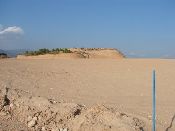|
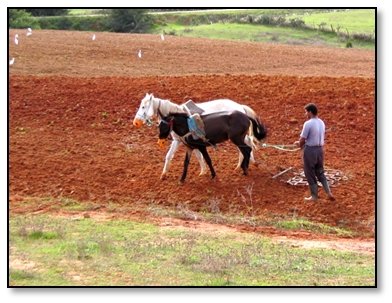 |
The North West of Morocco is characterized by a strong variation in seasonal rainfall from year to year. Ploughing is done at the first rains after September and with sufficient rainfall there will be a moderate harvest in February (mostly Wheat and Barley). If the crop fails it is used for fodder. For farmers in the area, annual rainfed crops for food production and livestock for immediate income is vital. There are no additional water sources and water conservation measures could help in this situation. |
Experiment: terracing and contour tillage
|
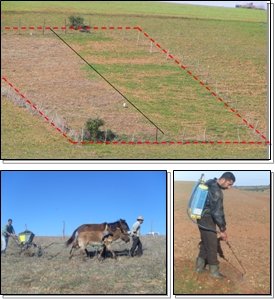 |
Ploughing is a necessary tillage operation to open the soil and eliminate weeds. However it also destroys the natural soil structure that is more stable and it may cause excessive evaporation and compaction may result in runoff and erosion.
The experiment compares a minimum tillage plot (left hand side) with conventional tillage to see if the water availability increases. Also a third plot was established: fallow with grazing (the normal practice). Additionally the minimum tillage plot was covered with natural mulch and residue. This should protect the soil from water and wind erosion and limit direct evaporation.
|
The soil is very stony and direct seeding was not possible, a seedbed was prepared with a shallow tillage operation. Also minimum tillage requires the application of herbicides for weed control. The first year light grazing was permitted; the second year the plot remained closed.
| This 2 year experiment was started in 2009 where weather conditions, soil moisture and soil properties are monitored, as well as yield parameters. Several sets of TDRs were used for soil moisture monitoring at 5, 15 and 30 cm depth. |
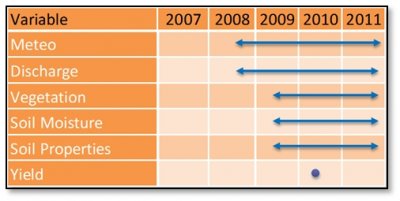 |
The experiment did not give clear results in water availability throughout the two year monitoring. In some periods the minimum tillage plot had more water, in some it has less than the fallow and normal tillage plots. The graphs below show the growing season from sep 2010 to april 2011, at 5 cm depth (top) and 30 cm depth (bottom).
The sensors near the surface show that the fallow plot is wettest (indicated with ‘Jach’) while the minimum and conventional tillage moisture contents are not significantly different (indicated resp. with ‘LMA’ and ‘LC’). The moisture content at 30 cm depth is markedly higher for the Minimum Tillage (LMA) and similar for conventional tillage and grazed fallow. An explanation for this is in the effect of surface cover. The fencing and mulch caused a much higher vegetation density in the minimum tillage plot, causing more interception of rainwater and a dryer soil near the surface Possibly the mulch and cover caused interception of rainwater. This prevented in fact infiltration which takes place on the fallow plot, and so that becomes wetter. The treatment seems to work for the deeper soil, where the minimum tillage is wetter than the fallow and the conventional tillage (which is driest). It is however not clear if this is a result of fencing and vegetation, or of the tillage itself.
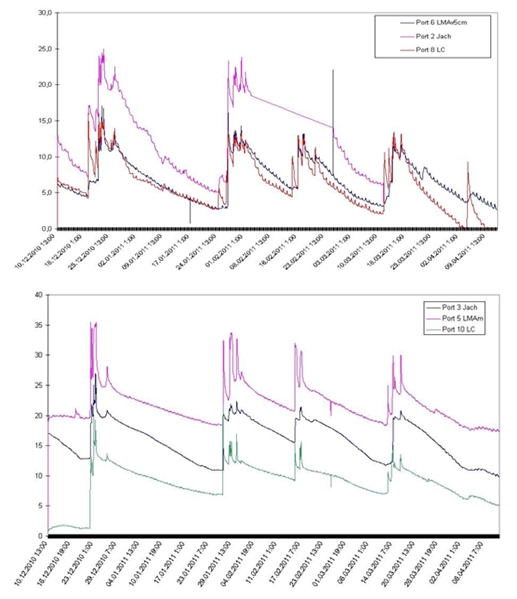
Moisture contents at 5 cm (top) and 30 cm (bottom) for the plots fallow+grazing (jach), conventional tillage (LC) and minimum tillage (LMA), for the growing season 2010-2011.
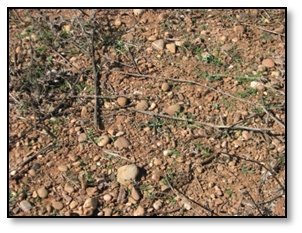 |
It is important to note that the soil on which the plot was established was not suited for minimum tillage. It is an old river deposit and very stony compared to other soil types in the region. The stoniness prevents the seeds from establishing properly which results in a loss of yield. Seeds are also more easily accesible to birds. Therefore some form of tillage is necessary in these circumstances. A different soil type with finer material may repond better to the measure. |
A main effect may be the fencing, which prevents grazing pressure and gives therefore higher yield results. A slight increase in yield is recorded: 545 kg/ha of Barley on the minimum tillage plot compared to 505 kg/ha on the conventional plot. The amount of straw was 1230 kg/ha and 1100 kg/ha respectively.
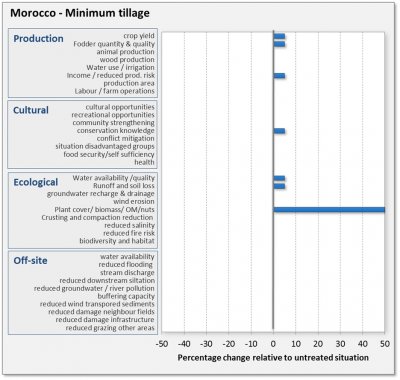 |
The results are evaluated from a production, socio-cultural and economic point of view. The bars express the estimated or measured percentage of change with respect to the reference situation. This change can be positive (blue) or negative (red). Note that this evaluation is based on the experiments, on the long term experience of the coordinating team in this area and on consultations with the farmers. |
| The farmers are not very convinced by the results. The small increase in grain yield and straw yield (used for fodder) was offset by the necessity for fencing in this experiment, which is seen as very negative. There is no visible improvement of the soil, and the location was not appropriate for minimum tillage because of the stoniness. Also there might not be sufficient material for mulch in this dry environment, which could increase pressure on natural areas for mulch production. |
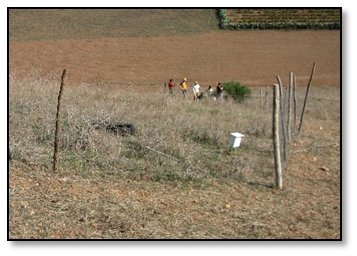 |
|
The experiment does not give clear results yet (although 2 years is short for a natural soil structure to re-establish). The increase in yield may be a result of the fencing, decreasing the grazing pressure. Also, minimum tillage as a conservation measure was not correct for this soil type: the stoniness hinders proper seed establishment. On a different soil type (also present in the area) the results might be better. As a positive effect a clear increase in water availability, especially deeper in the soil and later in the season, is observed.
|
|
There are strong cultural objectives against fencing (apart from the costs). Traditionally there is free range grazing as a strategy for survival. At the same time there is an increasing tendency of fencing in the region to confirm ownership. It is clear that Large scale application of minimum tillage would mean a complete revision of farm management, with controlled grazing (with or without fencing), harvest of fodder instead of grazing of stubble, etc. It is difficult to estimate the effects. The negative pressure on natural areas (forests) may actually increase when animals are excluded from some areas, while the better managed areas show a positive ecological effect(less runoff, better soils etc). In any case it is clear that a large scale management change has influences beyond the immediate change in tillage, and there must be a strong economic incentive before such changes would take place.
|
|

